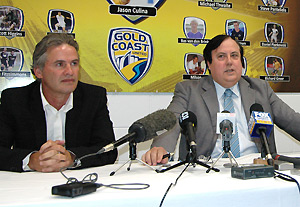
Gold Coast United club chairman Clive Palmer (right) and head coach Miron Bleiberg speak at a press conference at Skilled Park on the Gold Coast. AAP Image/Laine Clark
The A-League has suffered some pretty big kicks in the gut in its short history, yet few could compare to the wallop it copped yesterday when it was foretold that Gold Coast United was on the brink of extinction, chief executive Archie Fraser resigned from his post, and Robbie Fowler reportedly set to leave the beleaguered North Queensland Fury.
Even ardent supporters of the game couldn’t argue against the “A-League in crisis” headlines that swept through the media.
Only the news that Adelaide United’s new owners would take imminent control of the club and relieve the FFA of its controlling interest in the Reds dissuaded A-League fans from jumping off the proverbial bridge.
But none of us should have been shocked by the developments of the past 24 hours, particularly the struggles of the Fury and the Gold Coast.
Perhaps it’s hindsight talking, but the FFA should have foreseen the struggle of the expansion clubs to build a sufficient fan-base to sustain the clubs financially in areas that lack a substantial football following, in a climate in which the FFA is debilitated by no free-to-air coverage and almost non-existent levels of marketing.
Despite the comments made by Buckley and Gold Coast United CEO Clive Mensink that it was business as usual at the club, neither could give guaranteed assurances that the club would start its second season.
If Palmer has withdrawn his support for the club, it remains to be seen how involved the FFA will be in restructuring the club’s ownership model and propping it up if necessary.
At yesterday’s hastily arranged presser, Buckley stressed the need to gauge community support and local interest in the club for the FFA to step in and offer support for a franchise; an interesting point which seemed to indicate that the FFA remains unconvinced by the potential of a football club to survive in the long-term on the Gold Coast.
The shambolic first season of the club saw a catalogue of self-inflicted debacles, and it was always going to be very difficult for them to bounce back from those sorts of failings.
And the fundamental flaw in private ownership of football clubs means that clubs are at the whim of millionaires (billionaires, in Gold Coast’s case) who made their fortune and have skills in industries outside of the sporting world, and Palmer appears to have finally succumbed to the fiscal reality that the club would continue to bleed money.
The question now is whether Gold Coast United is a sustainable club.
Gold Coast may have been a strategic option in the A-League’s expansion, as Buckley said, but there remains little evidence to suggest it is a goldmine for Australian sporting codes.
Even when the FFA took charge of match-day operations, investing in marketing and promotion for Gold Coast’s home games, after the infamous crowd cap saga, crowd figures showed no signs of growing from their modest base.
Archie Fraser, who resigned as head of the A-League in the midst of Gold Coast’s soap opera, will now assume a new role in restructuring and revamping the Fury in addition to working with the Brisbane Roar and Gold Coast to help save the A-League’s three Queensland teams.
It’s a smart move.
The three clubs need all the help and assistance that they can get, and Fraser’s background suggests he works best at club level; allowing the FFA to find someone more suited for the leadership role in what is a challenging environment.
But the FFA cannot continue to prop up these clubs. It needs that money and effort to be invested in the wider areas of grassroots development, marketing, promotion and the like.
After such a chaotic day of developments, so many questions emerged.
Was the World Cup bid, with the time and investment it has gobbled up at FFA offices, a mistake considering the A-League’s foundations were still too weak to be left so exposed?
Was it too much of a risk to expand into Townsville and the Gold Coast, hardly football heartlands, especially when relying so heavily on the personal investment of so few individuals?
Should the FFA have done more to support these clubs at inception and in their infancy to build a fan base, perhaps awarding them the types of concessions other codes have given to their expansion franchises?
Should the FFA have gone with the safer options of Canberra and Wollongong, two areas with football backgrounds?
Or should the A-League have expanded sooner into Melbourne and Sydney with second teams?
The FFA understandably delayed on expanding with second teams in those cities to ensure the Victory and Sydney FC had time to evolve and develop – and the FFA needs the rivalries in these cities to develop when these second clubs enter to give the competition a much needed boost.
If they are successful, perhaps when we look back as the history of the A-League is written, we will bemoan the fact it took so long for the FFA to expand in these areas.
In the meantime, for the sake of all those involved at Gold Coast United, and the Fury and Roar, let’s hope a workable solution can be found which doesn’t sap the FFA.
The A-League cannot afford a franchise failure during this lean period.





























































































